

Fences, not only serve as boundary markers, they are a design element in their own right. There are so many styles from which to choose that you should have no trouble finding one that is both functional and decorative. The posts on this classic style are topped with decorative finials.
Landscape designs often benefit from vertical elements such as walls, fences, arches, arbors, pergolas, and decorative freestanding plant supports. Walls and fences help define boundaries while enclosing special spaces. Properly positioned, an arbor or arch is an eye-catching accent, adding visual drama to the scene and providing an attractive focal point or point of passage between two parts of the garden. A pergola transforms an ordinary path into a special, shaded, and sheltered passageway, while a freestanding plant support is like an exclamation point, drawing attention to itself and creating a pleasant focus.
As an added bonus, any one of these features provides an opportunity to grow and enjoy the wide range of climbing plants such as clematis, wisteria, climbing roses, honeysuckle, trumpet vine, and jasmine. These vertical plants add a sense of lushness to the garden as they scramble up walls and over trellised arches or droop heavy panicles of flowers through the open fretwork ceiling of a pergola. Here are some ideas for hardscaping your front yard with these elements.

The brick wall, that encloses this garden complements the brick pathway. Both have weathered to the point where they look as though they have always been part of the setting.

Consider installing a fence, as a backdrop to a group of lush plantings. This simple rail fence defines the garden path and separates the front yard from the side yard, but it also seems to support the flowering plants.

The classic picket fence, can be used with a variety of house styles. A purely decorative section of fence spans an opening in a hedge that borders the front yard of this house.
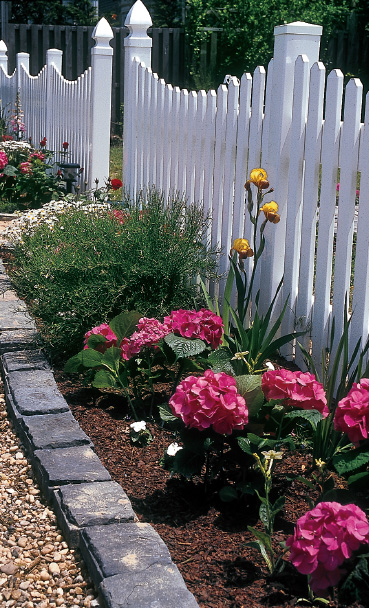
A traditional picket fence, serves as a backdrop for a group of border plants. In addition to their utilitarian functions, vertical elements such as fences and walls add texture and visual interest to a landscape.

Fence posts, especially posts that mark an entry, can become focal points if you add special cap treatments or adorn one with fresh flowers.
Erecting a fence is the quickest and generally easiest way to define the boundary of your property. To be a successful part of a landscape design, a fence should be planned to complement the architecture of your house, possibly even echoing a distinctive design feature. Also bear in mind the character of your neighborhood and region. Your fence may be beautiful in and of itself but look out of place in the neighborhood where you live. In addition to style, other considerations for making a fence harmonious with its surroundings include height, color, and material.
With that in mind, the possibilities for fence designs are limitless. Traditional options include wrought iron, wooden pickets (or palings), stockade, split-rail, double- and triple-bar ranch fences, and even chain-link fences. Within those basic styles are many variations. For example, iron can be wrought in fanciful designs from modern clean-cut to the fancy curlicues of the Romanesque style. Picket points can take the form of arrows, fleurde-lis, or any other design. The pickets can be spaced in a variety of ways. Stockade fences can be closed- or open-board, or have angled paling boards. To add extra charm and interest, a solid wooden fence can be topped with lattice. The main components of a board fence are pickets, horizontal rails, a top rail to protect the end grain of the pickets from moisture, the kickboard, and the support post.
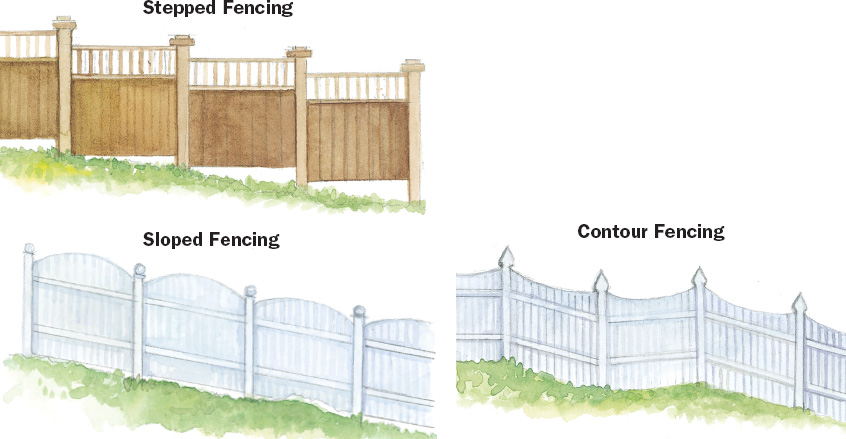
A slope presents a special challenge for fence design as fence sections are generally straight and parallel with the ground. Three possible solutions include stepping the fence down the slope, allowing gaps to occur as the slope progresses downward; building the fence to follow the hillside so that the top of the fence is angled at the same degree as the slope; and custom-building the fence so each paling touches the ground, creating a wavy line across the fence top and bottom.
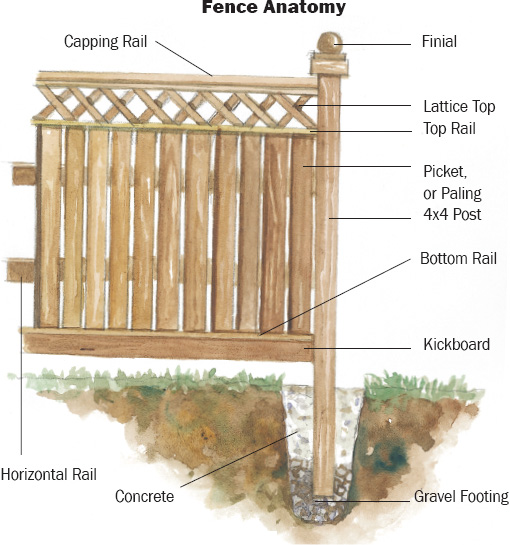
The garden gate meets many needs, from practical to aesthetic to psychological. It is a place of romance — where else would an ardent suitor steal a kiss or wait for a late-night romantic tryst but by the garden gate?
On the purely practical side, a gate allows passage to and between a front and back garden. This functional aspect is closely tied to a gate’s symbolic meaning. A locked, solid gate set in a high wall or fence provides a sense of privacy, enclosure, and security. A gate with an open design, even when set into a solid wall, has a welcoming air about it.
An open gate beckons; a tall, solid gate adds mystery, suggesting the entrance to a secret garden. It can guide the eye to a focal point or add charm, intimacy, drama, or panache.
Gates, even short ones that stand only 3 feet high, serve as important transition points from the garden to the outside world or from one part of the garden to another. They define boundaries while linking the two areas together. For that reason, gates and pathways tend to go together in a landscape design. Don’t confine your gates to the perimeter of your property. Use them within your garden as well, to divide space visually and to mark the boundaries between different areas or garden rooms.
Gates come in a seemingly endless variety of styles and sizes. Massive wrought-iron gates mark the entrances to many large Victorian parks and private estates. Painted, slatted gates set in white picket fences tend to belong with small, intimate cottages or traditional country homes. The gate to a vegetable plot at the bottom of the garden might be rough-hewn, in keeping with an untreated wooden fence designed to keep out foraging wildlife. Japanese moon gates have cutout circles symbolic of the full moon. These circles may be open or filled in with a fretted design of wood or iron to add visual interest and increase security.

Formal front yards, require a distinctive-looking entrance. The metalwork shown here works well with the formal brick wall and posts topped with decorative urns.

Step One: Space the Posts. Lay the gate on the ground, and position the posts on each side, allowing enough space for the hinges and latch. Make sure the tops and bottoms of the posts are even. Nail temporary battens onto the posts as shown. (The bottom batten should be at the bottom of the gate.)
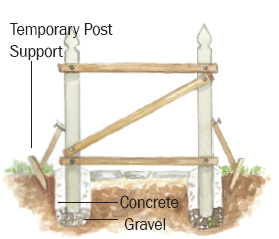
Step Two: Set the Posts. Dig postholes. Set the posts on a gravel bed, making sure the bottom batten is 3 inches off the ground and that the posts are plumb and level. Secure the posts temporarily with braces and stakes, and then fill the holes with concrete. Check again for plumb and level before the concrete sets.
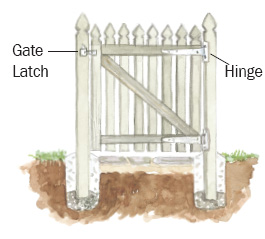
Step Three: Hang the Gate. When the concrete has completely cured, remove the braces and battens, attach the hinges (with the gate attached) to the post, and then attach the latch. The job is easier if one person holds the gate in position while the other person drills the screw holes and attaches the hardware.
Choose your gates to fit the style of your garden, but don’t be afraid to have fun. Use a terra-cotta color to blend with a Spanish-style house, or set a light-colored gate set against a dark backdrop of foliage.

Informal designs, put visitors at ease. This type of fence and gate is a good way to welcome visitors to a rear or side yard. It also helps support tall plants.
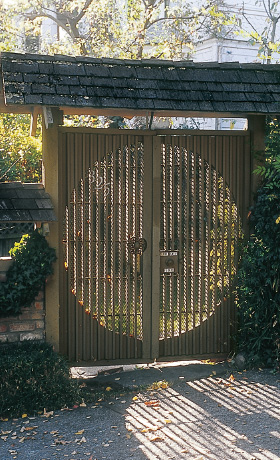
This distinctive gate, is attached to a house of similar style. Look to the facade of the house and the landscaping style of the front yard when selecting a fence and gate style.

Gates, don’t always need a fence. Here a decorative metal gate forms part of an arbor that is set in a hedge. This gate opens to a field beyond the garden.

The simple lattice design, of this fence is both appealing and practical. It not only encloses the garden but also serves as a trellis for climbing plants. A fence builder can create a custom design for you, or you can buy sections of fencing at home centers and fence speciality retailers.

This arbor and trellis, can serve as a destination in a large garden. You might find this type of structure in a front yard, but only in a very informal garden setting. Many large arbors contain a bench as part of the design. For interest, try placing a tall arbor in a rear or side yard that can be seen from the street.
Trellises were a key element in Renaissance gardens and continued in popularity through the eighteenth century. Trellises enjoyed a resurgence of popularity in the late-nineteenth century, but never to the extent of earlier times. Trellises can lend an air of magic and mystery to a garden. Generally, we think of trellises in terms of the prefabricated sheets of diamond- or square-grid lattice and the fan-shaped supports for training climbers, both of which are readily available at home and garden centers in both wood and plastic. Lacking a pattern book, most gardeners are unaware of the incredible variety of designs, patterns, and optical illusions that can be created with trellises.
A trellis screen is a wonderfully airy way to achieve privacy or to partition off a space. The lath slats of lattice interrupt the view without totally obscuring it, creating the effect of a transparent curtain. Left bare, the pretty design of diamonds or squares makes an attractive effect. Covered in vines or decorated with hanging baskets, a trellis screen is enchanting.
The art of treillage, as the French call it, is not limited to screens. You can cover a bare wall or unattractive fence with a trellis pattern. Arrange the trellis pieces to create an optical illusion of an archway in the wall. Paint a realistic mural of the make-believe garden space beyond. Use a trellis for the walls of a gazebo to provide enclosure without being claustrophobic. Put a trellis screen with a pleasing, intricate pattern at the end of a walkway as a focal point.

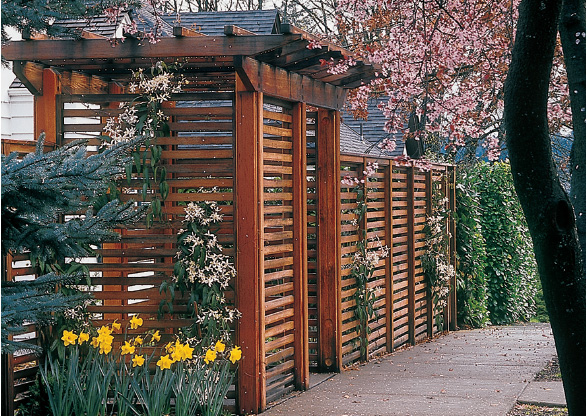
Closely spaced horizontal slats, topped with decorative beams combine to form a handsome trellis and arbor that forms a border in this garden. The slats on the structure provide some privacy without impeding air flow into the garden. Decorative posts and beams add interest when seen from the street.